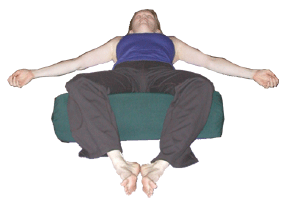In the above section on sequencing, we looked at a few postures that fit nicely at the end of the practice. While in Yin Yoga we do not need to cool down, we do want to restore the body to neutrality. Once we have completed our last pose, it is time for rest, and then a transition back to the world we left behind. The rest period is called “Shavasana.” [1]
 There are two parts to any exercise: stressing the body and resting the body. Most teachers, trainers, and students spend a great deal of time learning how to stress the body in a myriad of ways. And it is fun to do this. Equally important is Shavasana: the relaxation period at the end of the stressing period. Unfortunately, too many students are unaware of the need to balance stress with rest. They may skip their Shavasana, if they are practicing at home or by themselves. Or they may shorten it too much; better to shorten the other asanas and keep the full amount of time available for Shavasana.
There are two parts to any exercise: stressing the body and resting the body. Most teachers, trainers, and students spend a great deal of time learning how to stress the body in a myriad of ways. And it is fun to do this. Equally important is Shavasana: the relaxation period at the end of the stressing period. Unfortunately, too many students are unaware of the need to balance stress with rest. They may skip their Shavasana, if they are practicing at home or by themselves. Or they may shorten it too much; better to shorten the other asanas and keep the full amount of time available for Shavasana.
Personal trainers know that if we work one area of the body today, we need to let that area recover for at least thirty-six hours or more, depending upon our age and the strength of the workout we just did. Tomorrow, the trainer will work a different area, allowing the first area to get the rest it needs. Rest is essential for optimal performance of the body. When we use an area and let it relax, the body naturally ensures that the area becomes more usable in the future.
Not all forms of rest are equal. One medical study [2] showed that effects of stress were reduced in significantly shorter time by Shavasana than by simply sitting quietly or lying down. Shavasana is an active form of relaxing, which sounds like an oxymoron on the surface, but Shavasana has been proven to be the most effective form of rest possible. Don’t skip it!
- — See Yin Yoga Asana for details on Shavasana.
- — In the October 1998 Indian Journal of Physiology and Pharmacology.
(Next: Shavasana )
